Blaenavon
Blaenavon (Welsh: Blaenafon) is a town and community in Torfaen county borough, south eastern Wales. It lies at the source of the Afon Lwyd north of Pontypool, and is within the boundaries of the historic county of Monmouthshire and the preserved county of Gwent. The town lies high on a hillside and has a population of 6,055.
Blaenavon
| |
|---|---|
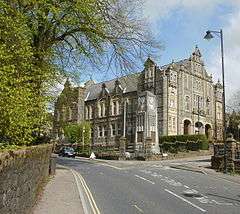 Blaenavon | |
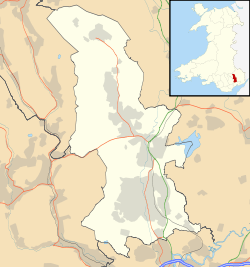 Blaenavon Location within Torfaen | |
| Area | 17.83 km2 (6.88 sq mi) [1] |
| Population | 6,055 (2011)[2] |
| • Density | 340/km2 (880/sq mi) |
| GSS code | W04000760 |
| OS grid reference | SO 255 095 |
| Community |
|
| Principal area | |
| Ceremonial county | |
| Country | Wales |
| Sovereign state | United Kingdom |
| Post town | PONTYPOOL |
| Postcode district | NP4 |
| Dialling code | 01495 |
| Police | Gwent |
| Fire | South Wales |
| Ambulance | Welsh |
| UK Parliament | |
| Senedd Cymru – Welsh Parliament |
|

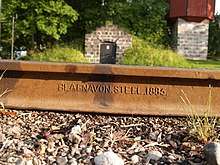
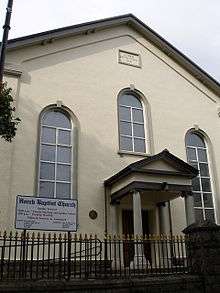

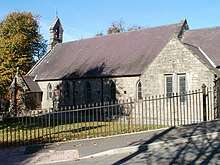
Parts of the town and surrounding country form the Blaenavon Industrial Landscape, inscribed as a World Heritage Site by UNESCO in 2000.
History
Blaenavon literally means "front of the river" or loosely "river's source" in the Welsh language. Blaenavon grew around an ironworks opened in 1788 by the West Midlands industrialist, Thomas Hill, and his partners, Thomas Hopkins and Benjamin Pratt. The businessmen invested £40,000 into the iron works project and erected three blast furnaces. Hopkins, through operating the Cannock Wood Forge in Rugeley, Staffordshire, was in contact with skilled and experienced ironworkers, and managed to persuade many of them to migrate to Blaenavon to help establish the new iron works. In 1836 Robert William Kennard formed the Blaenavon Coal and Iron Company, which subsequently bought the Blaenavon Ironworks.
Blaenavon House, a mansion constructed in 1798 by Thomas Hopkins, was re-purposed as a hospital supported by the subscriptions of local Iron and Coal workers in 1924. In the 1940s, the hospital site was gifted by the then owners of the site, the National Coal Board, to the Ministry of Health and was run as a cottage hospital until 1985. When the hospital closed the building was sold by the local authority and refurbished as a nursing home for the elderly. In 1995 the Building was listed as a Grade 2 Historic Building. The Building was left empty following the closure of the nursing home in 2007 and was badly vandalised and stripped of its lead work, slate Roof and original interiors, the building was placed on the Buildings At Risk register. In 2016, a fire caused severe damage to the ballroom wing and adjoining extension. The House was sold in 2017 to private owners and is currently undergoing restoration as a family home once again.
Governance
Blaenavon is a community represented by Blaenavon Town Council and electoral ward of Torfaen County Borough Council. Blaenavon is twinned with Coutras in France.[3]
Demography
Following twenty years after the closure of the ironworks in 1900 the population has declined gradually at each ten-year census, including rapidly after closure of the coal mine in 1980; it had however already fallen to 8,451 in 1961. Part of this decline was not emigration but a decrease in birth rate.[4]
Economy
The Blaenavon Coal and Iron Company developed the Big Pit coalworks with adjoining steel works particularly rail manufacture, part of which since 1988 is the museum.[5][6] The steel-making and coal mining industries followed, boosting the town's population to over 20,000 at one time before 1890.[7]
Culture and community
Government, publishers and mainly Welsh writers sought in 2003 to attract more visitors by introducing Blaenavon as Wales' second "book town" (the first being Hay-on-Wye on the English border). However the project did not succeed.[8] This can be attributed to a combination of the town's remote location and the established competition from Hay. Many thriving community groups serve and improve the town, including Future Blaenavon, which has helped to create a community garden at the bottom of the town.
Landmarks
Parts of the town and surrounding country form the Blaenavon Industrial Landscape, inscribed as a World Heritage Site by UNESCO in 2000. Attractions in the town include the Big Pit National Coal Museum (an Anchor Point of ERIH, The European Route of Industrial Heritage), Blaenavon Ironworks,[9] the Pontypool and Blaenavon Railway, Blaenavon World Heritage Centre, Blaenavon Male Voice Choir, Blaenavon Town Band and many historical walks through Blaenavon's mountains.
Transport
A railway viaduct was constructed in 1790 - a structure that disappeared and was unearthed in a 2001 episode of the archaeology television programme, Time Team. The Pontypool and Blaenavon Railway is a scenic attraction rich in geological and historical interest. Blaenavon lost both of its passenger railway stations — Blaenavon High Level station closed in 1941; the last train from Blaenavon (Low Level) (namely to Newport via Pontypool Crane Street) ran in April 1962. Contrary to an oral tradition, the lower line had already been closed for more than a year before the anti-subsidy Beeching Axe took place. The lower lines passenger service was among many in Gwent (Monmouthshire) were Ministry of Transport de-classified papers reveal were axed due to rail congestion in the Newport area following the newly opened Llanwern steelworks.
Education
Following Samuel Hopkins death in 1815, his sister Sarah Hopkins of Rugeley, who had inherited much money from her late brother, erected Blaenavon Endowed School in his memory.
Religious sites
St Peter's Church was constructed in 1804, gifted to the parish by Thomas Hill and Samuel Hopkins.
Sport
Blaenavon Golf Club (now defunct) was founded in 1906. The club closed in 1937.[10]
Notable people
Notable Broadway and film actor E. E. Clive, award-winning mystery writer Dorothy Simpson, and international rugby union players Mark Taylor (Wales), Ken Jones (Wales and British Lions and also Olympic athlete), John Perkins (Wales), Chris Huish (Wales) Terry Cobner (Wales and British Lions) were all born in Blaenavon. Nick Thomas-Symonds, elected MP for Torfaen in 2015, was brought up in the town. The artist David Parfitt[11][12] grew up in Blaenavon. Well-known for his portraits and paintings of the River Thames, the influence of the hybrid rural-industrial Welsh valleys of the 1950s and early 1960s is clear in his early work, and continues to inspire his painting today.
See also
References
- "2011 Census:Quick Statistics:Population Density for Blaenavon". Office for National Statistics. Archived from the original on 3 December 2013. Retrieved 29 November 2013.
- "2011 Census:Key Statistics:Key Figures for Blaenavon". Office for National Statistics. Archived from the original on 2 December 2013. Retrieved 25 November 2013.
- "Town Twinning". Torfaen County Borough Council. Retrieved 20 September 2016.
- http://www.visionofbritain.org.uk/unit/10045757/cube/TOT_POP
- Ironworks photo at geograph
- McCrum, Kirstie (7 September 2013). "Going Underground; Big Pit: National Coal Museum Is Celebrating Its 30th Anniversary as a Tourist Attraction and Museum". Western Mail. Retrieved 14 June 2016 – via Questia.
- Workmen's Hall photo at geograph
- the Book Guide: Blaenafon - The Booktown Experiment Fails, 17 March 2006 Archived 23 October 2012 at the Wayback Machine. Accessed 2 November 2012
- Blaenavon Ironworks
- “Blaenavon Golf Club”, “Golf’s Missing Links”.
- https://www.newenglishartclub.co.uk/artists/david-parfitt-neac. Missing or empty
|title=(help) - http://www.dgparfitt.co.uk/
External links
| Wikimedia Commons has media related to Blaenavon. |
- Old photos of Blaenavon
- Welsh Coal Mines - all the pits, all the histories
- Blaenavon Town Council
- Time Team - The Lost Viaduct
- Aerial photograph of Blaenavon in 1999
- Blaenavon Local History Society website
- Chisholm, Hugh, ed. (1911). . Encyclopædia Britannica. 4 (11th ed.). Cambridge University Press.

